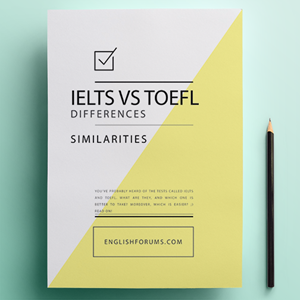You’ve probably heard of the tests called IELTS and TOEFL. What are they, and which one is better to take? Moreover, which is easier? Read on!
IELTS stands for “International English Language Testing System”, while TOEFL means “Test of English as a Foreign Language”. They are both international, standardized tests of English language proficiency. Either IELTS or TOEFL can be required if you’re planning to study in an English-speaking country as a non-native speaker of English.
IELTS vs TOEFL: similarities
Both tests are very common and accepted by universities around the world. Both are aimed at evaluating how well you can communicate with other English-speaking people, as well as how confident you feel in an English environment. Both have 4 sections: listening, reading, writing and speaking. Both focus on academic English rather than on general English. Both have to be paid for. The fee depends on where you take the test and can vary from $160 to $250. Results of both the tests are valid for 2 years.
IELTS vs TOEFL: differences
- IELTS is divided into the General Training Version and the Academic Version. The General IELTS is intended for people who want to immigrate or gain work experience in an English-speaking country. The Academic IELTS is designed for those who want to apply for higher education in an English-speaking country. Therefore, if studying abroad isn’t one of your aims, it’s a good idea to take the General IELTS. The Academic Version of IELTS is the equivalent of TOEFL, which is an academic test.
- IELTS is based on British English, while TOEFL is focused on American English.
- IELTS is a paper and face-to-face test, while TOEFL is normally internet-based. There are a few countries where TOEFL is paper-based, but most of them are located in Asia and Africa.
- There is also a substantial difference in how results are calculated. IELTS scores for each section are averaged and rounded to make an Overall Band score, which ranges from 0 to 9 with 0,5 score step. TOEFL results are a sum of scores received in all the sections with a maximum of 120 marks (30 marks per section).
Let’s have a closer look at the differences in each test section.
Speaking
In IELTS you speak with an examiner face to face. In TOEFL you speak into a microphone, your answers are recorded and sent to an examiner. In fact, your conversation with an examiner in IELTS is recorded too, but it’s done for objectivity’s sake. If you disagree with your Speaking score, you can lodge an appeal, and the review board will listen to that exact recording.
Writing
IELTS writing is going to be easier for those who are used to working with paper and a pencil. TOEFL writing texts seem longer because they are viewed on a screen. There’s also an interesting task in IELTS that doesn’t have an equivalent in TOEFL: you’ll need to describe a graph, a table, or a diagram. TOEFL Writing Task 2 is complex; you have to read a text, then listen to an audio file, and then write an essay based on the information you’ve received.
Listening
In IELTS you can see all the questions before you listen to an audio file, which later helps you to focus on the bits that contain the answers to the given questions. In TOEFL you first listen to an audio and make notes, then you see the questions and answer them. All the recordings in TOEFL are academic, which means they are lectures and conversations between students. In IELTS there are 2 dialogues on general topics.
Reading
TOEFL reading questions are multiple-choice, while IELTS reading questions are more diverse. They can be multiple-choice, but you can also be asked to fill in blank fields, to put paragraphs in the right order, to add captions to a diagram, or to insert data in a table, etc.
IELTS vs TOEFL: summary
Both IELTS and TOEFL test the same skills, however designs, format and time are different. It’s always a good idea to double check which test is accepted/required by your university, and to find out how the two tests work. Much of the success in test-taking comes from being familiar and comfortable with the test format.
Read this article in Russian: Чем IELTS отличается от TOEFL?


 Clap
Clap
